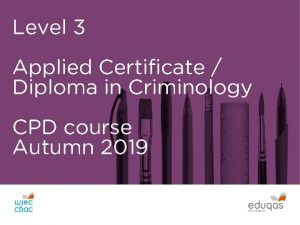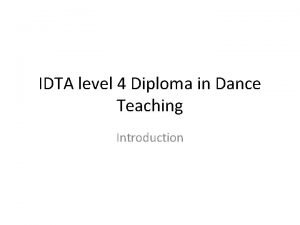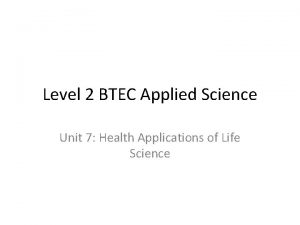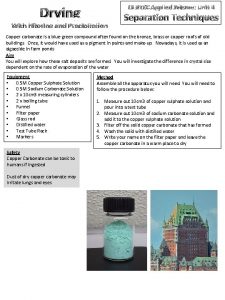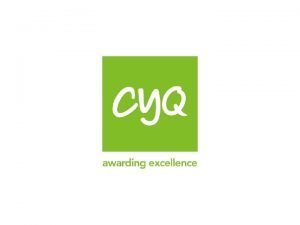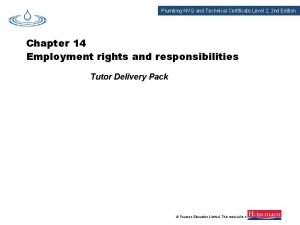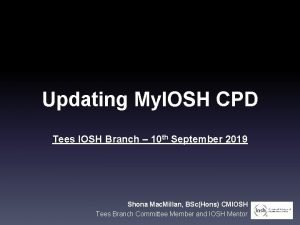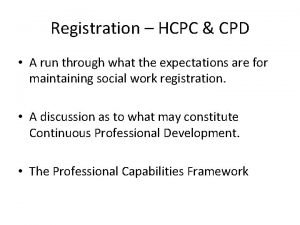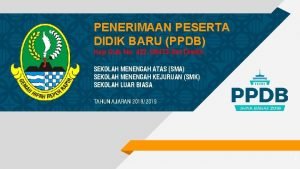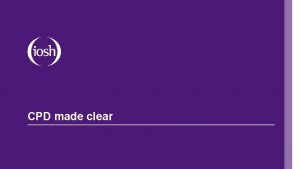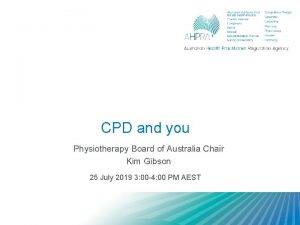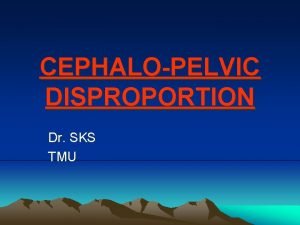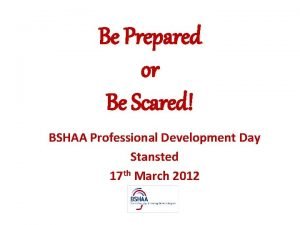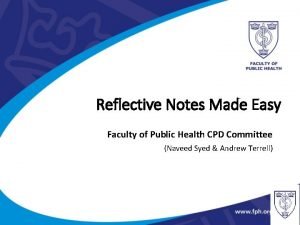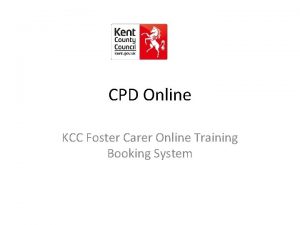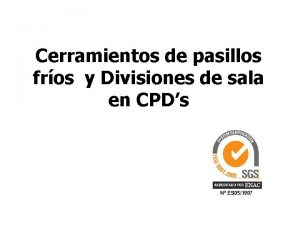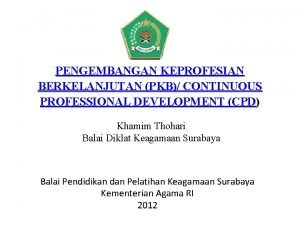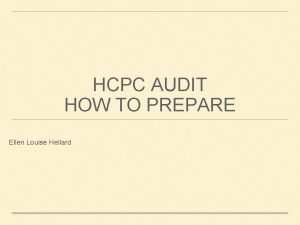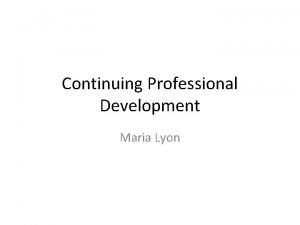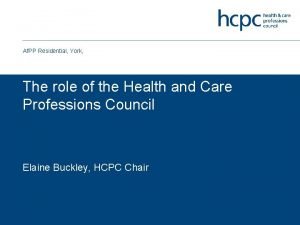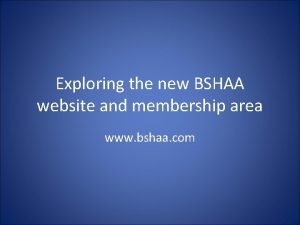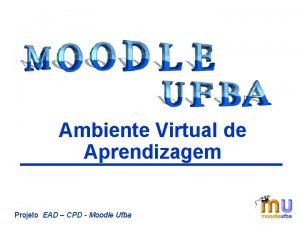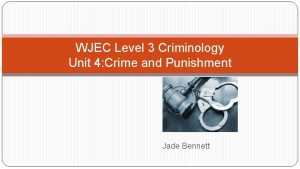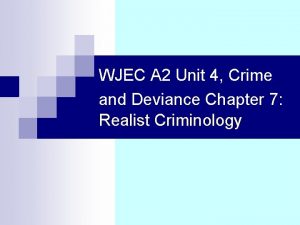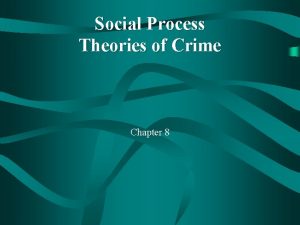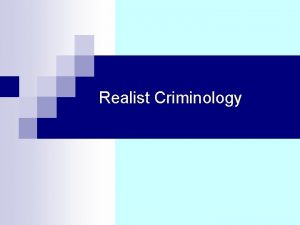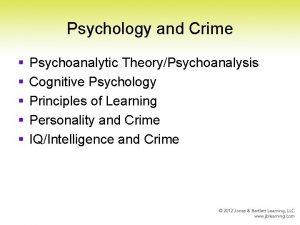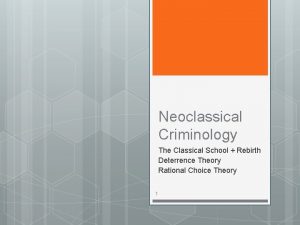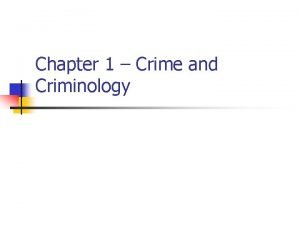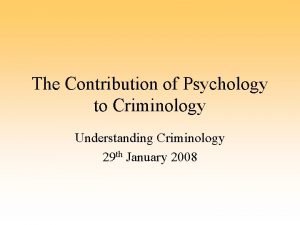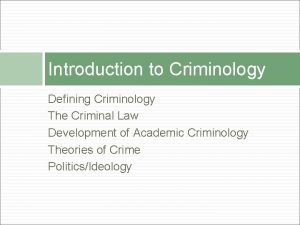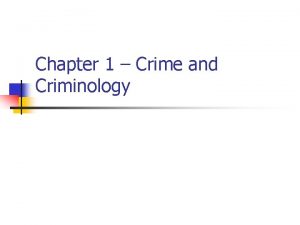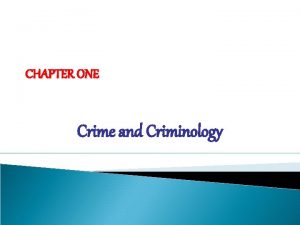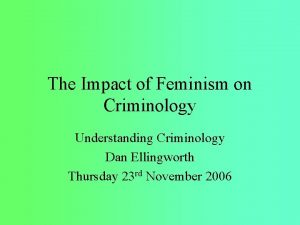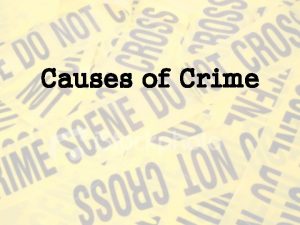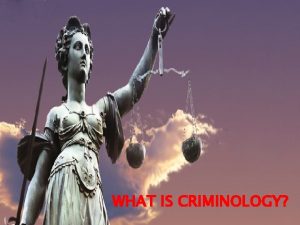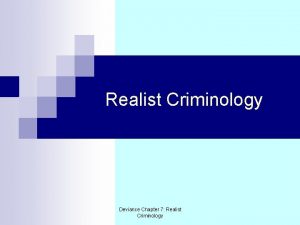Level 3 Applied Certificate Diploma in Criminology CPD




































































- Slides: 68

Level 3 Applied Certificate / Diploma in Criminology CPD course Autumn 2019

Course Overview Ø Ø Ø Ø Ø Welcome and housekeeping Qualification structure Resources to support you Session 1: Introduction to new examination paper structure Coffee Session 2: Units 2 and 4 example answer review The aims of controlled assessment and overview of changes for 2020 Lunch Session 3: Unit 3 workshop Session 4: Unit 1 workshop Q and A and feedback End

Preliminary Entries are collected for the June series for GCE, GCSE, Entry Level, Vocational Awards/Certificates, and Applied Certificates/Diplomas Where? Must be submitted online via WJEC's secure website www. wjecservices. co. uk Why? Preliminary entries are an important source of information for WJEC, and are used to calculate the despatch of examination stationery, pre-release materials and early exam papers to centres When? The deadline for submission of preliminary entries is 10 th October.

Audio Recording The presenters are required to make an audio recording of this event. This is a control designed to ensure that WJEC is able to demonstrate compliance with regulatory Conditions of Recognition; specifically Conditions relating to the confidentiality of assessment materials. The recording will be made available to the qualifications regulator if required, but it will not be shared with any other third parties. The recording will be stored securely by WJEC for a period of three years and then permanently destroyed. Please note that delegates are NOT PERMITTED to make an audio or video recording of any aspect of this event.

Qualification structure

Near pass rule The specification states that from 2020: Learners must pass each unit in order to achieve a grade for the qualification. However, a near pass rule has been introduced for external units meaning that candidates can achieve a near pass (N) grade if they achieve the total UMS required for the relevant grade and have obtained the minimum UMS for the relevant external units.

UCAS points The qualification carries UCAS points. It has been confirmed by Df. E that the WJEC/Eduqas Applied Level 3 Criminology qualification will be included on the performance tables until 2022 (England centres only). A* 56 A 48 B 40 C 32 D 24 E 16

Resources to support you • • • Specification and Sample Assessment Materials (website) Past papers and mark schemes (secure website) 2019 FAQ document (website) CPD materials (website) Online Exam Review (oer. wjec. co. uk/oer. eduqas. co. uk) Textbooks (available from Illuminate and Napier Press) https: //www. eduqas. co. uk/qualifications/criminology/ https: //www. wjec. co. uk/qualifications/criminology/index. html

Session 1: Introduction to new examination paper structure

Command word glossary

Layout and tariffs

Layout and tariffs

Layout and tariffs

Layout and tariffs

Session 2: Units 2 and 4 example answer review

The aims of controlled assessment and an overview of changes for 2020

The aim of controlled assessments……. Controlled assessment is intended to: • ensure that all candidates taking a specific qualification spend approximately the same amount of time on their assignments • prevent third parties from providing inappropriate levels of guidance and input • mitigate concerns about plagiarism and improve reliability and validity of results • allow centres an appropriate degree of freedom and control • allow candidates to produce an original piece of work.

The aim of controlled assessments……. Controlled assessment is intended to: • ensure that all candidates taking a specific qualification spend approximately the same amount of time on their assignments • prevent third parties from providing inappropriate levels of guidance and input • mitigate concerns about plagiarism and improve reliability and validity of results • allow centres an appropriate degree of freedom and control • allow candidates to produce an original piece of work.

General guidance on conducting Criminology controlled assessments • • All WJEC/Eduqas controlled assessments are summative Controlled assessment tasks should not be attempted until all teaching and learning for that unit has taken place Once teaching has ended, centres may decide how best to organise the 8 hours of controlled assessment time. This can be split over a suitable number of sessions If the 8 hours are split, candidate notes must be stored securely between sessions. Candidates are not allowed to augment notes and resources between sessions.

General guidance on conducting Criminology controlled assessments • • Candidates are allowed to take class notes or their own prepared notes into Criminology controlled assessments, but they should not be allowed access to any USB or storage devices where work completed outside the controlled assessment environment could be accessed Centres are advised to plan ahead to ensure that any logistical problems associated with supervision or IT resources are minimised.

General guidance on conducting Criminology controlled assessments • • From September 2019, at the centre’s discretion, candidates are allowed a fresh attempt at WJEC/Eduqas controlled assessments Where candidates are attempting the task for the second time within the same academic year, a different learner assignment brief must be used for the fresh attempt Assessors are not permitted to provide the candidate with feedback between attempts Both attempts must be submitted to the moderator when fresh attempt candidates are included in the sample.

Administration of moderation samples • • • Centers are reminded to ensure that each candidate signs the Criminology Mark Record Sheet once the work is completed. This declaration must also be signed by the assessor and lead assessor (where relevant) Along with the candidate samples for moderation and record sheets, centres should send one copy of the learner assignment brief selected Centres should also include one completed copy of the Quality Assurance Form to detail the marking and internal standardisation procedures (where relevant) followed in relation to the sample.

Session 3: Unit 3 – Crime Scene to Courtroom

Session 3: Unit 3 – Crime Scene to Courtroom 1. 2. 3. 4. Overview Key points from external moderation series 2019 General guidance on planning and delivery Delivering Unit 3 and applying the mark scheme effectively (with review of exemplars)

Unit 3 – Crime Scene to Courtroom Overview 1. 2. 3. 4. 5. Title: ‘Crime Scene to Courtroom’ – a law based unit 90 teaching hours – recommended Internal Assessment and External Moderation 8 -hour controlled assessment time Assignment briefs available from Eduqas secure website (the context can be adapted but changes have to be agreed with WJEC/Eduqas) 6. Unit 3 is marked out of 100 7. Unit 3 is 25% of the overall qualification (Level 3 Applied Diploma) 8. Evidence to justify centre marks should be provided in two ways: annotation on candidate scripts and general comments

Unit 3 – Crime Scene to Courtroom Key points Timings • Try to get your candidates to match timings and the marks available. For example: • 8 hours (480 minutes) for 100 marks • 6 mark questions = maximum 29 minutes (6% of the time allocated) • 15 mark questions = maximum 72 minutes (15% of the time allocated).

Unit 3 – Crime Scene to Courtroom Key points Use of Brief and case studies • Currently, for Unit 3, the Assignment Brief can be shared with candidates prior to controlled assessment (CA) • However, evidence should NOT just come from the Gareth Hughes brief (or alternative brief used) • Use other relevant case studies. These could include: Amanda Knox, Barry George, Becky Watts, Colin Stagg, Stephen Lawrence, Jeremy Bamber,

Unit 3 – Crime Scene to Courtroom Key points • Amplification Use the Amplification notes (in the Specification), as well as the Mark Bands, to help guide candidates on the exact requirements of each Assessment Criteria (AC) e. g. AC 1. 1 Evaluate the effectiveness of the roles of personnel involved in criminal investigations Content: Amplification • crime scene investigators Learners should have an understanding of the • forensic specialists • forensic scientists • roles of the personnel involved and be able to police officers/detectives • Crown Prosecution evaluate their effectiveness in criminal Service (CPS) • pathologist • other investigations. The effectiveness should be investigative agencies, e. g. Serious and considered in the context of potential Organised Crime Agency, HM Revenue & limitations: • cost • expertise • availability Customs

Unit 3 – Crime Scene to Courtroom Key points • • • Most centres successfully followed the strict regulations laid out for conducting the controlled assessment Textbooks - are not allowed in the controlled assessment environment. Teachers must bear this in mind when producing notes for candidates – some candidates re-write paragraphs from the textbook verbatim and this should not be credited as their own work Internet – no access to the internet is allowed during Unit 3 controlled assessment. As a result, no hyperlinks or images would be expected within candidate work.

Unit 3 – Crime Scene to Courtroom Key points • • Assessment Structure and Annotation Best practice is to use a report format with headings and sub-headings related to the assessment criteria (AC) wording Assessors must annotate candidate work to clearly illustrate why it is worthy of the mark awarded Assessors should annotate concisely in the body of candidate work and refer to mark band criteria where appropriate Overall justification for the marks awarded should be provided on the Mark Record Sheet.

LO 1 AC 1. 1 to AC 1. 4 Understand the process of criminal investigation

LO 1 – AC 1. 1 A/C Mark Band 1 AC 1. 1 Limited Evaluate the evaluation of effectiveness of the roles of effectiveness of personnel the relevant involved in roles. Response criminal is largely investigations descriptive and may only be a list of personnel involved. (1 -3) Mark Band 2 Mark Band 3 Some evaluation of the effectiveness of relevant roles. Description of the roles of personnel involved is also evident. (4 -7) Clear and detailed evaluation of the effectiveness of roles. The personnel involved are clearly discussed in terms of potential limitations. (8 -10) Mark Band 4

LO 1 – AC 1. 1 A/C Mark Band 1 AC 1. 1 Limited Evaluate the evaluation of effectiveness of the roles of effectiveness of personnel the relevant involved in roles. Response criminal is largely investigations descriptive and may only be a list of personnel involved. (1 -3) Use cost, availability and expertise (amplification) to evaluate effectiveness Mark Band 2 Candidates should not over describe the roles Mark Band 3 Mark Band 4 Some Clear and detailed evaluation of the effectiveness of roles. The relevant roles. personnel involved Description of are clearly the roles of discussed in terms personnel of potential involved is also limitations. evident. (8 -10) (4 -7) All three points (cost, availability and expertise) do not need to be applied to all roles

LO 1 – AC 1. 2 A/C AC 1. 2 Assess the usefulness of investigative techniques in criminal investigations All techniques should be covered, selecting appropriate situations and types of crime Mark Band 1 Mark Band 2 Mark Band 3 Mark Band 4 A largely descriptive response with very limited, basic/simple assessment. At the lower end, investigative techniques may be simply listed. (1 -5) Limited evidence of relevant assessment of the use of investigative techniques. At the lower end, some investigative techniques are described. (6 -10) A range of investigative techniques are used to make some assessment of their usefulness in criminal investigations. (11 -15) Clear and detailed assessment is made of a wide range of investigative techniques. (16 -20) In Band 3, candidates may have used case studies and/or strengths and weaknesses to assess usefulness but the evaluation would not be sustained and/or developed Sustained and detailed evaluation made using case studies and/or strengths and weaknesses.

LO 1 – AC 1. 3 A/C Mark Band 1 AC 1. 3 Basic response Explain how that may only evidence is list procedures processed or mention case studies. (1 -3) Case studies are required – Amanda Knox and Barry George are useful examples Mark Band 2 Mark Band 3 Mark Band 4 Clear and detailed explanation of how evidence is processed using relevant examples. (4 -6) How evidence is processed may also be credited elsewhere but teacher annotations should be clear Both physical and testimonial evidence and coverage of all 5 processes required (collection, transfer, storage, analysis and personnel involved)

LO 1 – AC 1. 4 A/C Mark Band 1 AC 1. 4 The rights of Examine the individuals in rights of criminal individuals in investigations criminal are simply listed investigations or may have limited description. (1 -3) Arrest through to appeal must be covered Mark Band 2 Mark Band 3 Mark Band 4 The rights of individuals in criminal investigations are clearly examined. (4 -6) Suspects, victims and witnesses should be covered but not necessarily in equal detail Include relevant legislation

LO 2 AC 2. 1 to AC 2. 5 Understand the process for prosecution of suspects

Marks could be achieved in AC 1. 1 (Full Mark Test Band Code) 3 Mark Band 4 – please annotate accordingly LO 2 – AC 2. 1 A/C AC 2. 1 Explain the requirements of the Crown Prosecution Service (CPS) for prosecuting suspects Mark Band 1 Mark Band 2 A simple/basic explanation of the CPS with little or no reference to the prosecution of suspects. (1 -2) Detailed explanation including clear and relevant examples of the requirements (tests) of the CPS in prosecuting suspects. (3 -4) May not include any legislation Relevant case studies used to illustrate the ‘Full Code Test’ Candidates should include relevant legislation – as laid out in: Criminal Justice Act, 2003 Prosecution of Offences Act, 1985

LO 2 – AC 2. 2 A/C AC 2. 2 Describe trial processes Mark Band 1 Mark Band 2 A simple/basic Describes in description of some detail the trial processes stages of the trial and/or personnel process, involved. May including the only be a list. personnel (1 -2) involved. (3 -4) Case studies must be based on the court case and not the investigation Mark Band 3 Mark Band 4 Describe briefly – timings are important – 19 minutes max. time on this Each of the stages of the trial process must be included and reference made to the personnel involved Be careful not to allow students to copy out of a textbook verbatim

LO 2 – AC 2. 3 A/C Mark Band 1 Mark Band 2 AC 2. 3 Understand rules in relation to the use of evidence in criminal cases A simple/basic understanding of the rules in relation to the use of evidence in criminal cases. (1 -2) Detailed understanding of the rules in relation to the use of evidence in criminal cases. (3 -4) Case studies must be based on the court case and not the investigation May not include legislation Mark Band 3 Mark Band 4 Legislation and case law required Relevance, admissibility, disclosure and hearsay required. HOWEVER, candidates do not need to explain different types of evidence in detail – this already covered in AC 1. 3

LO 2 – AC 2. 4 A/C AC 2. 4 Assess key influences affecting the outcomes of criminal cases Case studies must be based on the court cases and not the investigation Mark Band 1 Mark Band 2 Key influences Understanding of affecting the key factors outcomes of affecting the criminal cases outcomes of are largely criminal cases is described. shown and some (1 -3) assessment made of their impact (4 -7) All influences included in the content column are not needed in equal detail but should all be covered for full marks Mark Band 3 Assesses key influences affecting the outcomes of criminal cases. There is clear and detailed understanding of their impact (8 -10) Candidates Markclearly Band 4 assessing impact – case studies support assessments made Largely descriptive with a few strengths and weaknesses. Evaluation may be limited or lack case study support for assessments

LO 2 – AC 2. 5 A/C AC 2. 5 Discuss the use of laypeople in criminal cases Mark Band 1 A basic/simple description of juries and magistrates. (1 -3) Candidates should NOT overly describe the roles of lay people Mark Band 2 Mark Band 3 The use of laypeople (juries and magistrates) are discussed fully in relation to their strengths and weaknesses in criminal cases. (4 -6) Evaluation should discuss the impact of these strengths and weaknesses Mark Band 4

LO 3 AC 3. 1 to AC 3. 2 Be able to review criminal cases

LO 3 – AC 3. 1 A/C AC 3. 1 Examine information for validity Mark Band 1 Limited information sources are described (listed at the lower end). At the top end, some information sources are discussed in relation to validity. (1 -5) Must include a range of case studies and key terminology Mark Band 2 Should not be a description of Mark Band 3 Mark Band 4 cases but an Detailed examination A range of information examination of a sources are relevant range of examined and information reviewed in sources. There is terms of their a clear review of validity. At their suitability in bottom end, the terms of validity. range of (11 -15) information sources and/or the review will be limited. (6 -10) Bias, opinion, circumstances, currency and accuracy Examination of the brief (where relevant) and other case studies required The assessor cannot infer, so the candidate needs to be clear if discussing evidence, trial transcripts, media reports etc.

LO 3 – AC 3. 2 A/C Mark Band 1 AC 3. 2 Draws Draw conclusions on conclusions from criminal cases. information Conclusions may be mainly subjective, with limited evidence used in support. (1 -5) Marks capped at Band 1 – if the candidate only uses the brief Mark Band 2 Draws some objective conclusions on criminal cases, using some evidence and reasoning in support of conclusions. (6 -10) Mark Band 3 Draws objective conclusions on criminal cases, using evidence and clear reasoning/argum ent in support of conclusions (11 -15) Candidates should discuss: Just verdicts Miscarriages Safe Verdict Just sentencing Mark Band 4 Examination of the brief and other case studies required for Band 3 Candidates should say why a particular case is just/unjust and not simply describe the full case

Session 4: Unit 1 – Changing Awareness of Crime

Session 4: Unit 1 – Changing Awareness of Crime 1. 2. 3. Changes to briefs General guidance on planning and delivery Delivering Unit 1 and applying the mark scheme effectively

Adaptation of selected Assessment Criteria (AC) in the specification Justification – clarification of the breadth needed to satisfy the demand of each AC. Changes made • AC 1. 1 – number of crimes reduced to two • AC 1. 2 – number of crimes reduced to two • AC 1. 6 – clarification of two statistical sources • AC 3. 1 – students’ chosen campaign must relate to a crime identified in the brief.

Adaptation of rules governing the administration of the controlled assessment Justification – all centres subject to a clear set of rules on administration of the tasks. Changes made: • Two tasks replaced by six • Candidates can no longer see the brief or tasks prior to the controlled assessment • Fresh-attempts are allowed but candidates must use a different brief. Both attempts must be submitted to WJEC if a fresh-attempt candidate appears in the requested sample (no feedback allowed between attempts).

General guidance: Submissions Work should be presented in a report style and organised with headings and sub-headings e. g. • Task 1 (Main Heading) • AC 1. 1 (Sub-Heading) • AC 1. 2 (Sub-Heading) • Task 2 (Main Heading) • AC 1. 3 (Sub-Heading) • AC 1. 4 (Sub-Heading) etc.

General guidance: Organising CA sessions • Centres may split the 8 hours into shorter sessions. Where this occurs, centres should release tasks one at a time, or as relevant to the number of sessions organised • Where tasks 5 and 6 are split, task 6 should be completed before task 5 – students need to create their own campaign (task 6) before they can compare it to other campaigns (task 5) • All student notes should be completed before the first session and stored securely in between sessions

LO 1 AC 1. 1 to AC 1. 6 Understand how crime reporting affects the public perception of criminality

LO 1 – AC 1. 1 A/C Mark Band 1 Mark Band 2 AC 1. 1 Description of Analysis of Analyse two types of two types different crime evident of crime types of in the evident in the crime assignment brief. (1 -2) (3 -4) Mark Band 3 Mark Band 4

LO 1 – AC 1. 1 A/C AC 1. 1 Analyse different types of crime Candidates should not over describe the crimes Mark Band 1 Mark Band 2 Mark Band 3 Mark Band 4 Description of Analysis of two types of crime evident in the assignment brief. (3 -4) (1 -2) Will need to include description of crimes evident and fully analyse two crimes found in the brief (content). Full analysis includes – example of offence, typical offender, typical victim, level of public awareness, is it criminal behaviour (amplification)

LO 1 AC 1. 1 Your Turn Analyse different types of crime Hate crime, honour crime and domestic abuse will be identified separately in any brief

LO 1 – AC 1. 2 A/C AC 1. 2 Explain the reasons that certain crimes are unreported Mark Band 1 Mark Band 2 Mark Band 3 Reasons for Clear and the two detailed unreported explanation of crimes are the reasons for limited in the two explanation. unreported (1 -2) crimes. (3 -4) Band 2 work will explain reasons why both crimes identified in AC 1. 1. could go unreported. Answers may be brief for 4 marks but must include at least one personal and one social/cultural reason (content) Mark Band 4

LO 1 – AC 1. 3 A/C AC 1. 3 Explain the consequences of unreported crime Mark Band 1 Mark Band 2 Limited Clear and detailed explanation (may only list (includes examples) of relevant examples) the of the consequences of of unreported crime. (3 -4) (1 -2) For Band 2 (full marks), all consequences should be covered but coverage will likely be brief, e. g. definition and example Mark Band 3 Mark Band 4 Consequences Ripple Effect Cultural Decriminalisation Police priorities Unrecorded crime Cultural change Legal change Procedural change

LO 1 – AC 1. 4 A/C AC 1. 4 Describe media representation of crime Mark Band 1 Mark Band 2 Mark Band 3 Limited Detailed description of the media representation of of crime (1 -3 ) including relevant examples. (4 -6) Candidates Overview of all media types needed: Newspapers, TV, Film, Electronic Gaming, Social Media and Music Describe how media represents crime WITH examples Mark Band 4 need to think about the language, images etc. that are used BUT there is no need to describe impacts in this AC. Discussion of impacts is relevant to AC 1. 5

LO 1 – AC 1. 5 A/C AC 1. 5 Explain the impact of media representation s on the public perception of Crime Mark Band 1 Mark Band 2 Clear and Limited detailed explanation of the impact of explanation of the media impact of a range of media representations s on the public perception of perception crime. of crime. (1 -3) (4 -6) A detailed explanation needed on the IMPACT of the media on public perceptions Mark Band 3 Mark Band 4 Impact must cover all specified content: • Moral Panic • Changing public perceptions • Stereotyping • Levels of response • Changing priorities and emphasis

LO 1 – AC 1. 6 A/C Mark Band 1 Mark Band 2 Clear and detailed AC 1. 6 Limited (may only list methods / evaluation of two Evaluate sources of methods/sources of methods of information) information used to collecting evaluation collect information statistics about of two methods of about crime with clear crime collecting evidence of information reasoning. about crime. Detailed and relevant (1 -3) reference to specific sources. (4 -6) Cover the two sources that are identified in the specification 1. Police Recorded Crime 2. Crime Survey Mark Band 3 Mark Band 4 Evaluation needs to briefly cover: 1. Reliability 2. Validity 3. Ethics 4. Strengths and limitations 5. Purpose of research

LO 2 AC 2. 1 to AC 2. 2 Understand how campaigns are used to elicit change

LO 2 – AC 2. 1 A/C Mark Band 1 Mark Band 2 Mark Band 3 Clear and detailed AC 2. 1 Limited Some comparison of a range of comparison of a range Compare awareness of campaigns for of relevant campaigns for change. There are for change. Explicit for change. some links to planned Evidence is planned campaign with mainly campaigns to reference to descriptive. support decision specific and (1 -3) making. (4 -7) appropriate sources to support The content column of the conclusions. specification lists different types of (8 -10) campaigns for change. Candidates do NOT have to cover all different types in this list. All four campaigns can be on a similar theme e. g. changing the law Mark Band 4 Four or more campaigns are needed e. g. three examples and the candidate’s own Marks beyond Band 2 cannot be awarded if they do not include discussion of their own campaign

LO 2 – AC 2. 2 A/C AC 2. 2 Evaluate the effectiveness of media used in campaigns for change Does not have to be linked to campaigns in AC 2. 1 Mark Band 2 Limited Some evaluation of the effectiveness of media used in a range of media campaigns for used in relevant change. campaigns for Evidence is change. mainly Response is descriptive and largely limited in range. descriptive but (1 -5) includes some appropriate judgements. (6 -10 ) Mark Band 3 Clear and detailed evaluation of effectiveness of a range of media used in relevant campaigns for change. Clear evidence of well reasoned judgements to Support conclusions. (11 -15) Mark Band 4 Minimum of four media types needed. Each needs own evaluation For Band 3, evaluation should be detailed and include positives and negatives as well as examples of effectiveness of different media in selected campaigns

LO 3 AC 3. 1 to AC 3. 3 LO 3 Plan campaigns for change relating to crime

LO 3 – AC 3. 1 A/C Mark Band 1 Mark Band 2 Mark Band 3 Plan for Detailed and AC 3. 1 Plan a campaign appropriate plan campaign relevant to for campaign, for change selected relevant to relating to assignment brief, selected crime is limited in detail. has evidence of assignment brief, Appropriate some includes clearly actions, appropriate described sequences and actions in a time are relevant time briefly outlined. sequence in sequence. (8 -10) (1 -3) some detail. (4 - The plan needs to include: aims and 7) objectives, justify choice of campaign, target, methods/materials/resources to be used, finances and must show understanding of a TIMELINE. Mark Band 4 The campaign must be directly RELATED to the brief Candidates should bear in mind that underreported crimes provide more scope to raise awareness!

Candidates cannot use pictures from real life campaigns – unless they make them their own A/C LO 3 – AC 3. 2 Mark Band 1 AC 3. 2 Design Materials are materials basic/simple for use in in design. campaigning Limited for change clarity of purpose for the materials. (1 -5) A minimum of three materials should be produced e. g. poster, social media and/or leaflet Mark Band 2 Candidates need to show technical skills and images must be visually stimulating Mark Band 3 Mark Band 4 Well-designed Some evidence Attractive attractive of materials are materials which designed with presented. are designed relevant content Content is with relevant which stimulates appropriate content and interest. Evidence for changing which stimulate of persuasive behaviour. some interest. language and Materials are Some evidence clarity of purpose. visually and verbally of Some evidence of stimulating persuasive technical skills. and technically language and (11 -15) accurate. clarity of purpose. (16 -20) (6 -10) Use of the internet is allowed but no access previously designed campaign materials Materials must be persuasive and give a clear and consistent message

LO 3 – AC 3. 3 A/C Mark Band 1 AC 3. 3 Justify a campaign for change Limited justification of a campaign for change. Evidence is largely descriptive with few judgements. (1 -5) This AC requires justification for the campaign (to include the need for it). Use case law and stats to help Mark Band 2 Mark Band 3 Mark Band 4 Some Clear and justification is detailed well-reasoned. justification Response is which is welllargely reasoned. descriptive but Conclusions are includes some supported by appropriate relevant judgements Persuasive including the use language is used. of persuasive (6 -10) language. (11 -15) Also looking for justification of methods and materials, target audience etc. Can annotate materials to help! Candidates need to avoid simply describing their campaign

Any Questions? Contact our specialist Subject Officers and administrative support team for your subject with any queries. Neil Evans Erin Roberts Caroline Redman Robert Williams Subject Officer Externally Assessed units Subject Officer Internally Assessed units Subject Support Officer Wales Centres criminology@wjec. co. uk England Centres criminology@eduqas. co. uk Tel: 02922 404287
 Whats vcal
Whats vcal Wjec criminology unit 4 exam 2020
Wjec criminology unit 4 exam 2020 Wjec criminology unit 3 answers
Wjec criminology unit 3 answers Btec level 3 extended diploma in performing arts
Btec level 3 extended diploma in performing arts Cache 3 diploma
Cache 3 diploma Idta teaching qualifications
Idta teaching qualifications Pearson btec level 3 health and social care
Pearson btec level 3 health and social care Lmi4all
Lmi4all As a laboratory assistant you measure chemicals
As a laboratory assistant you measure chemicals Btec applied science level 3 unit 7
Btec applied science level 3 unit 7 Btec applied science level 3 unit 4
Btec applied science level 3 unit 4 Ncfe level 1 certificate in employability skills
Ncfe level 1 certificate in employability skills Mtac panel
Mtac panel Cyq
Cyq Plumbing nvq and technical certificate level 3
Plumbing nvq and technical certificate level 3 Cyq level 2
Cyq level 2 My iosh cpd
My iosh cpd Idd cpd
Idd cpd Wwwsaim
Wwwsaim Retrieval practice cpd
Retrieval practice cpd Cpd act of 2016
Cpd act of 2016 Basw pcf
Basw pcf Hkie scheme a cpd
Hkie scheme a cpd Cpd ketm
Cpd ketm Ratesetter legal finance
Ratesetter legal finance Pharmacy revalidation
Pharmacy revalidation Iclear cpd
Iclear cpd Physiotherapy cpd portfolio examples
Physiotherapy cpd portfolio examples Cpd strategy
Cpd strategy Ciri cpd
Ciri cpd Cpd in obstetrics
Cpd in obstetrics Cpd record template
Cpd record template Reflective notes example
Reflective notes example Rcog associate
Rcog associate Csp cpd portfolio
Csp cpd portfolio Kent cpd online
Kent cpd online Cerramiento pasillos cpd
Cerramiento pasillos cpd Cpd 1501
Cpd 1501 Contoh cpd guru
Contoh cpd guru Hcpc audit notification
Hcpc audit notification Caracteristicas cpd
Caracteristicas cpd Cpd formula coupon
Cpd formula coupon Vocational training scheme
Vocational training scheme Perbedaan mtki dan ktki
Perbedaan mtki dan ktki Maria lyon
Maria lyon Odp cpd
Odp cpd Python cpd
Python cpd Moray cpd
Moray cpd Hkicpa cpd event
Hkicpa cpd event Cpd test
Cpd test Rcr reflection template
Rcr reflection template Iosh cpd development plan
Iosh cpd development plan Hkis cpd
Hkis cpd Bshaa
Bshaa Eduqas a level literature
Eduqas a level literature Babcock ldp cpd
Babcock ldp cpd Litdrive uk
Litdrive uk Cpd moodle
Cpd moodle Wjec criminology unit 4 advanced information
Wjec criminology unit 4 advanced information Criminology unit 2 revision
Criminology unit 2 revision Criminology unit 4 quiz
Criminology unit 4 quiz Social bonds theory
Social bonds theory Classical school of thought
Classical school of thought Miller's focal concerns
Miller's focal concerns Realist criminology
Realist criminology Psychoanalytic theory criminology
Psychoanalytic theory criminology Neoclassical criminology
Neoclassical criminology Developmental theories of crime
Developmental theories of crime School of thought in criminology
School of thought in criminology


